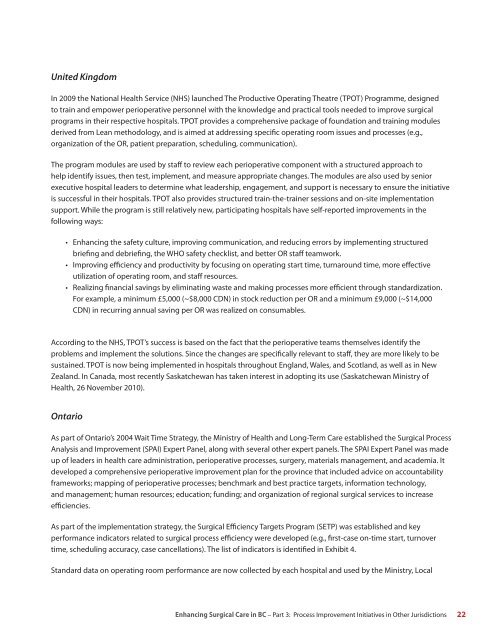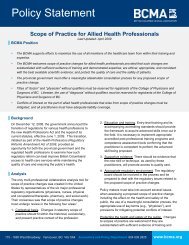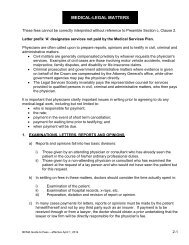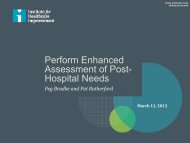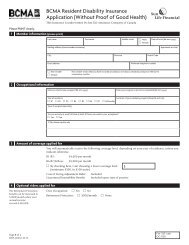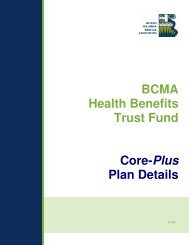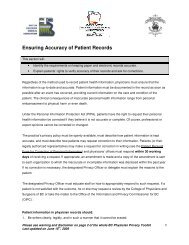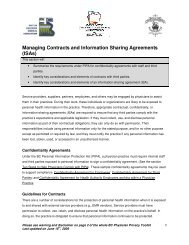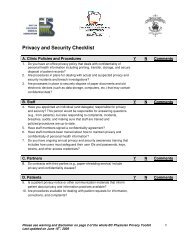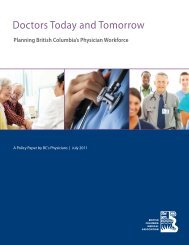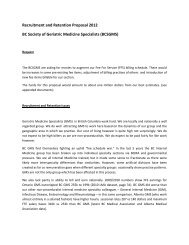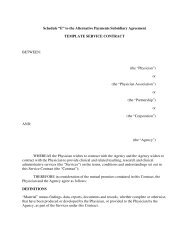Enhancing Surgical Care in BC - British Columbia Medical Association
Enhancing Surgical Care in BC - British Columbia Medical Association
Enhancing Surgical Care in BC - British Columbia Medical Association
Create successful ePaper yourself
Turn your PDF publications into a flip-book with our unique Google optimized e-Paper software.
United K<strong>in</strong>gdom<br />
In 2009 the National Health Service (NHS) launched The Productive Operat<strong>in</strong>g Theatre (TPOT) Programme, designed<br />
to tra<strong>in</strong> and empower perioperative personnel with the knowledge and practical tools needed to improve surgical<br />
programs <strong>in</strong> their respective hospitals. TPOT provides a comprehensive package of foundation and tra<strong>in</strong><strong>in</strong>g modules<br />
derived from Lean methodology, and is aimed at address<strong>in</strong>g specific operat<strong>in</strong>g room issues and processes (e.g.,<br />
organization of the OR, patient preparation, schedul<strong>in</strong>g, communication).<br />
The program modules are used by staff to review each perioperative component with a structured approach to<br />
help identify issues, then test, implement, and measure appropriate changes. The modules are also used by senior<br />
executive hospital leaders to determ<strong>in</strong>e what leadership, engagement, and support is necessary to ensure the <strong>in</strong>itiative<br />
is successful <strong>in</strong> their hospitals. TPOT also provides structured tra<strong>in</strong>-the-tra<strong>in</strong>er sessions and on-site implementation<br />
support. While the program is still relatively new, participat<strong>in</strong>g hospitals have self-reported improvements <strong>in</strong> the<br />
follow<strong>in</strong>g ways:<br />
• <strong>Enhanc<strong>in</strong>g</strong> the safety culture, improv<strong>in</strong>g communication, and reduc<strong>in</strong>g errors by implement<strong>in</strong>g structured<br />
brief<strong>in</strong>g and debrief<strong>in</strong>g, the WHO safety checklist, and better OR staff teamwork.<br />
• Improv<strong>in</strong>g efficiency and productivity by focus<strong>in</strong>g on operat<strong>in</strong>g start time, turnaround time, more effective<br />
utilization of operat<strong>in</strong>g room, and staff resources.<br />
• Realiz<strong>in</strong>g f<strong>in</strong>ancial sav<strong>in</strong>gs by elim<strong>in</strong>at<strong>in</strong>g waste and mak<strong>in</strong>g processes more efficient through standardization.<br />
For example, a m<strong>in</strong>imum £5,000 (~$8,000 CDN) <strong>in</strong> stock reduction per OR and a m<strong>in</strong>imum £9,000 (~$14,000<br />
CDN) <strong>in</strong> recurr<strong>in</strong>g annual sav<strong>in</strong>g per OR was realized on consumables.<br />
Accord<strong>in</strong>g to the NHS, TPOT’s success is based on the fact that the perioperative teams themselves identify the<br />
problems and implement the solutions. S<strong>in</strong>ce the changes are specifically relevant to staff, they are more likely to be<br />
susta<strong>in</strong>ed. TPOT is now be<strong>in</strong>g implemented <strong>in</strong> hospitals throughout England, Wales, and Scotland, as well as <strong>in</strong> New<br />
Zealand. In Canada, most recently Saskatchewan has taken <strong>in</strong>terest <strong>in</strong> adopt<strong>in</strong>g its use (Saskatchewan M<strong>in</strong>istry of<br />
Health, 26 November 2010).<br />
Ontario<br />
As part of Ontario’s 2004 Wait Time Strategy, the M<strong>in</strong>istry of Health and Long-Term <strong>Care</strong> established the <strong>Surgical</strong> Process<br />
Analysis and Improvement (SPAI) Expert Panel, along with several other expert panels. The SPAI Expert Panel was made<br />
up of leaders <strong>in</strong> health care adm<strong>in</strong>istration, perioperative processes, surgery, materials management, and academia. It<br />
developed a comprehensive perioperative improvement plan for the prov<strong>in</strong>ce that <strong>in</strong>cluded advice on accountability<br />
frameworks; mapp<strong>in</strong>g of perioperative processes; benchmark and best practice targets, <strong>in</strong>formation technology,<br />
and management; human resources; education; fund<strong>in</strong>g; and organization of regional surgical services to <strong>in</strong>crease<br />
efficiencies.<br />
As part of the implementation strategy, the <strong>Surgical</strong> Efficiency Targets Program (SETP) was established and key<br />
performance <strong>in</strong>dicators related to surgical process efficiency were developed (e.g., first-case on-time start, turnover<br />
time, schedul<strong>in</strong>g accuracy, case cancellations). The list of <strong>in</strong>dicators is identified <strong>in</strong> Exhibit 4.<br />
Standard data on operat<strong>in</strong>g room performance are now collected by each hospital and used by the M<strong>in</strong>istry, Local<br />
<strong>Enhanc<strong>in</strong>g</strong> <strong>Surgical</strong> <strong>Care</strong> <strong>in</strong> <strong>BC</strong> – Part 3: Process Improvement Initiatives <strong>in</strong> Other Jurisdictions 22


